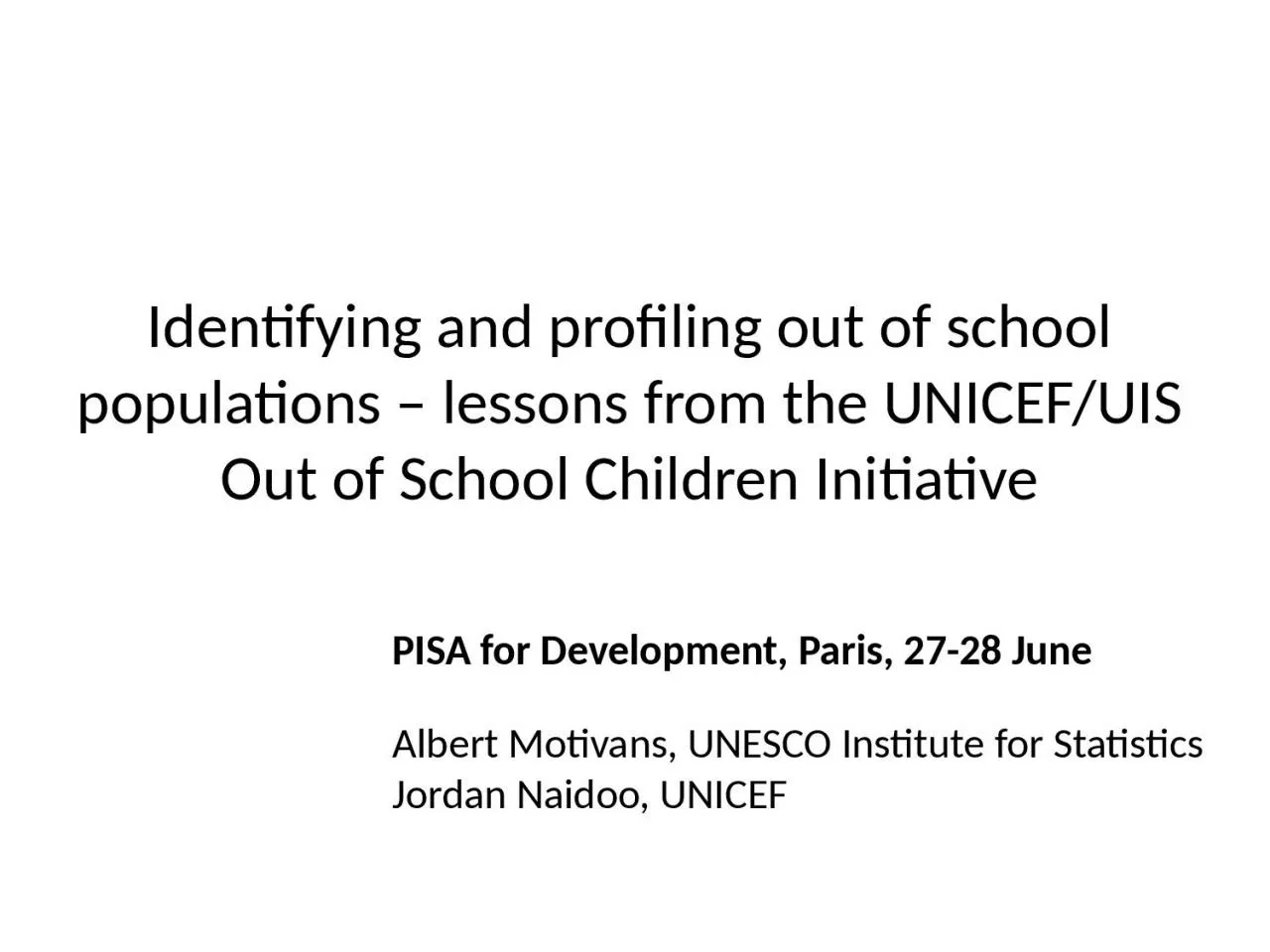

PISA for Development Paris 2728 June Albert Motivans UNESCO Institute for Statistics Jordan Naidoo UNICEF Slowdown in educational progress Number Number of primary schoolaged children out of school 2000 2011 ID: 1045651
Download Presentation The PPT/PDF document "Identifying and profiling out of school ..." is the property of its rightful owner. Permission is granted to download and print the materials on this web site for personal, non-commercial use only, and to display it on your personal computer provided you do not modify the materials and that you retain all copyright notices contained in the materials. By downloading content from our website, you accept the terms of this agreement.
1. Identifying and profiling out of school populations – lessons from the UNICEF/UIS Out of School Children InitiativePISA for Development, Paris, 27-28 JuneAlbert Motivans, UNESCO Institute for StatisticsJordan Naidoo, UNICEF
2. Slowdown in educational progressNumberNumber of primary school-aged children out of school, 2000- 2011
3. An unfinished education agenda69 million young adolescents were out of school31 million out-of-school young adolescents in South and West Asia although there much progress for girls Sub-Saharan Africa (22 million) has been almost no change in participation rates or gender parityLittle progress in reducing dropout–34 million children left school before reaching the last grade of primary education - an early school leaving rate of 25% – the same level as in 2000.
4. What is the Out of School Children Initiative?Objective: To reduce the number of out of school children by addressing gaps in data collection, analysis and policy on out of school children- National teams/partners coordinated by UNICEF and UISAround half of the world’s OOSC live in these countries
5. Three core objectivesData: Develop comprehensive profiles of excluded children drawing on a range of data sources using innovative measurement approaches2. Analysis of barriers: Link quantitative data with the socio-cultural barriers and resource-based bottlenecks that create exclusion3. Implement policies: Identify policies which reduce exclusion from education (especially among groups most disadvantaged) from a multi-sectoral approach
6. Five dimensions of exclusion modelData sources: Administrative data/hh-based surveysKey outputs: OOS Typologies and disaggregated profiles
7. Problems in identifying age cohortsAdministrative data (supply-side)School reporting problematic, capture systems weakOften collected in completed years not. DOBAge distribution seems to overstate participation in younger ages – and understate (or gets right?) older agesHousehold survey data (demand-side)Proxy reporting problematic, age-heapingOften collected in completed years not. DOBAge distribution seems to overstate participation in older ages – understate (or gets right?) younger ages
8. Population distribution by single year of age Nigeria, 2008
9. Where are 15 year olds in schools?
10. Source: Brazil OOSCI report http://www.uis.unesco.org/Education/Documents/OOSCI%20Reports/brazil-oosci-report-2012-pr.pdf% students who are one or more years over-age by grade and location, 2009Overage pupils by grade in Brazil
11. Lower secondary school age students by level attended in Zambia, 2007Source: UIS calculations based on Zambia DHS 2007
12. Where are 15 year-old girls in Cambodia?Source: DHS, Cambodia 2010-11
13. School attendance by age and household wealthIndia 2000Indonesia 2002-03Mali 2001Nigeria 2003
14. How many and who are out of school?
15. Source: UIS calculations based on Pakistan DHS 2006-07Out-of-school children of lower secondary school age, Pakistan, 2006-07
16. Source: UIS calculations based on Pakistan DHS 2006-07School exposure of out-of-school children, by household wealth in Pakistan, 2006-07
17. Out-of-school children from poor householdsare more likely to never attend school-21-12-211315232329334573-20020406080Difference "will never attend" poorest-richest (%)BoliviaKyrgyzstanZambiaBrazilColombiaCambodiaDR CongoLiberiaKenyaTimor-LesteGhanaYemenNigeriaSource: Household survey data, 2006-2010. Data for children of primary school age.
18. ConsiderationsThere is potential for using OOSCI results to help design a strategy to reach youthIn schools (across grades and levels)Outside of schoolsDisadvantage mediates school progression and out of school statusRecognise technical limitationsMeasuring age is problematicCoverage issues (reaching most disadvantaged)Use of national data for targeting and profiling is still limited Sampling strategiesPresenting assessment results On-time, late, out of school